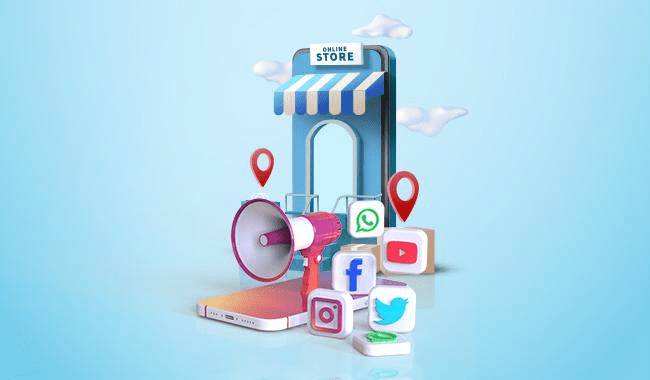What Is Social Media Marketing ?
Social media marketing is a form of digital marketing that involves creating and sharing content on social media platforms to achieve marketing and branding goals. The primary objective of social media marketing is to connect with your target audience, build brand awareness, drive website traffic, and ultimately, increase sales or achieve other business objectives.

Benefit Of Social Media Marketing
Social media marketing can be a powerful tool for growing a business in various ways. Here are some key benefits of social media marketing for business growth:
Increased Brand Awareness:
- Social media platforms provide a vast reach, allowing businesses to showcase their brand to a broad audience. Regularly sharing content, engaging with followers, and utilizing visual elements contribute to increased brand visibility and awareness.
Targeted Advertising:
- Social media platforms offer advanced targeting options for advertising. Businesses can tailor their ads to specific demographics, interests, and behaviors, ensuring that they reach the most relevant audience for their products or services.
Improved Customer Engagement:
- Social media facilitates direct communication between businesses and their audience. Engaging with customers through comments, messages, and social media polls not only builds stronger relationships but also helps businesses understand and respond to customer needs and concerns.
Drive Website Traffic:
- Social media platforms serve as effective channels for driving traffic to a business’s website. By strategically sharing blog posts, product pages, and other content, businesses can direct their social media audience to their website for more information or to make a purchase.
Lead Generation:
- Social media platforms can be valuable for lead generation. By creating compelling and shareable content, running targeted ad campaigns, and utilizing lead generation forms, businesses can attract potential customers and capture their contact information for further engagement.
Social Media Marketing Platform

- Users: 1.9 billion daily active users worldwide
- Audience: An even spread of Generation X and Millennials
- Industry impact: B2C
- Best for: Brand awareness; advertising; community building
Facebook is the largest social media platform and the most established. Since its launch in 2004, it has become an invaluable tool for B2C businesses, offering advanced advertising tools as well as organic opportunities.

- Users: 1 billion monthly active users
- Audience: Primarily Millennials
- Industry impact: B2C
- Best for: High-quality images and videos; user-generated content; advertising
Although Instagram launched only 12 years ago, the platform has taken the world by storm. When it comes to sharing visually compelling content, Instagram is where brands go. Another thing that sets the platform apart is its advanced ecommerce tools.
Today, users can discover brands, browse their products and/or service, and complete a purchase without ever leaving the app – making Instagram a hard platform to beat.
YouTube

- Users: Over 315 million daily active users worldwide
- Audience: Primarily Millennials but has a strong audience across gender and age demographics
- Industry impact: B2C and B2B
- Best for: Brand awareness; long-form entertainment; how-to and explainer videos; SEO; advertising
According to HootSuite, YouTube is the second most visited website in the world. In addition, marketers name it the best platform to build community.
In addition to being an incredibly popular platform, its users also tend to stay longer on it because it features mostly long-form content – making it an ideal platform to share educational content.
Role Of Social Media In Building Brand Loyalty
In an era defined by digital connections, social media has emerged as a powerful tool not only for reaching wider audiences but also for fostering deep and lasting connections with consumers. This blog post aims to explore the integral role social media plays in building brand loyalty and the strategies businesses can employ to create a loyal and engaged customer base.
Understanding Brand Loyalty in the Digital Age:
- Defining brand loyalty and its significance in today’s competitive market.
- Exploring the evolving nature of loyalty in the context of digital interactions.
The Influence of Social Media on Consumer Behavior:
- Examining how social media platforms shape consumer perceptions and purchasing decisions.
- Case studies illustrating the impact of positive social media interactions on brand loyalty.
Creating Authentic Connections:
- The role of authenticity in building trust and loyalty.
- Strategies for showcasing the human side of your brand through social media.
Engagement Strategies that Foster Loyalty:
- Developing interactive content to engage and involve the audience.
- The impact of responding promptly to comments, messages, and user-generated content.
Exclusive Content and Offers:
- Utilizing social media platforms to provide exclusive content and special offers.
- Showcasing the value of being a part of the brand’s social media community.
The Impact Of Social Media Marketing On Business Growth
In the digital age, where connectivity knows no bounds, social media marketing has emerged as a driving force behind business growth. This blog explores the profound impact that social media marketing can have on businesses, from startups to established enterprises, and how it serves as a catalyst for sustainable growth.
Amplifying Brand Visibility:
- Discuss how social media platforms provide businesses with a global stage, allowing them to showcase their products, services, and brand personality to a vast audience.
- Explore the concept of brand visibility as a crucial foundation for business growth.
Engaging and Connecting with the Target Audience:
- Highlight the role of social media in facilitating direct and meaningful interactions between businesses and their target audience.
- Showcase examples of successful engagement strategies that contribute to building a loyal customer base.
Driving Website Traffic and Conversions:
- Examine how social media serves as a powerful traffic driver, directing users to business websites and online platforms.
- Explore conversion strategies, including the role of compelling calls-to-action and targeted landing pages.
Building and Strengthening Brand Loyalty:
- Investigate how consistent and authentic communication through social media contributes to the development of brand loyalty.
- Share real-world examples of businesses successfully fostering long-term relationships with their audience.
Social Commerce: Turning Followers into Customers:
- Delve into the rising trend of social commerce, where businesses can seamlessly integrate e-commerce features into their social media platforms.
- Explore how social media becomes a direct revenue channel, allowing for product discovery and purchasing within the same platform.

Social Media Strategy
1. Set Clear Objectives:
- Define specific and measurable goals, such as brand awareness, lead generation, website traffic, or community engagement.
- Align your social media objectives with your overall business goals.
2. Know Your Target Audience:
- Create detailed buyer personas to understand your audience’s demographics, interests, and behaviors.
- Tailor your content and messaging to resonate with your target audience.
3. Choose the Right Platforms:
- Select social media platforms that align with your target audience and business objectives.
- Consider the strengths of each platform and focus your efforts where your audience is most active.
4. Develop a Content Strategy:
- Plan a content calendar with a mix of content types, including images, videos, blog posts, and curated content.
- Ensure your content provides value, educates, entertains, or solves a problem for your audience.
5. Engagement and Community Building:
- Foster a sense of community by engaging with your audience through comments, messages, and discussions.
- Encourage user-generated content and actively participate in relevant conversations.
6. Incorporate Visual Elements:
- Leverage the power of visuals to capture attention. Use high-quality images, infographics, and videos to enhance your content.
- Consider the aesthetics of your brand and maintain a consistent visual identity.
7. Social Media Advertising:
- Utilize paid advertising options on platforms like Facebook, Instagram, and LinkedIn to expand your reach.
- Define your target audience, set a budget, and monitor the performance of your ads.
